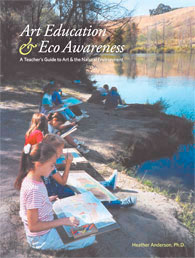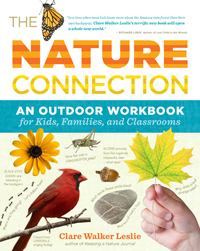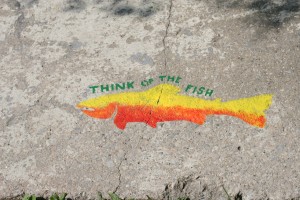I had the pleasure recently of attending a workshop led by naturalist Clare Walker Leslie, who is a prolific artist and author. Clare is a passionate proponent of art-based nature journalling, well-evidenced in her many journals. Seeing her journals is a delight – they are rich with drawings of the natural world, observations, and connections to her experiences. Her drawing style is beautiful – in some cases, quick and gestural to capture the shape of a bird before it flies off into the bush; in others, detailed, well-worked watercolours or coloured pencil drawings created in her studio from outdoor sketches and field guides. She spends a lot of time in classrooms with students, encouraging them to use drawing (or mark-making, as she prefers to call it) as a way to closely observe the flora and fauna around them – an important step towards developing their ecological literacy. Clare delivered three workshops in Toronto, including one at the Master of Teaching Environmental Education conference at OISE. It was refreshing to get outside – yes, even in a cold Ontario winter – just to draw, and to be reminded of the power of journaling as an ongoing learning activity for learners of all ages.  For more info on Clare, or to order one of her books, please visit her website at: Â
Art Education & Eco-Awareness
As part of a conference I presented at in the fall (All Hands in the Dirt, at Evergreen Brick Works) I was asked to present on how to keep students making art outside when the weather turns cold. That day we did some outdoor stenciling, but it reminded me of the power of taking art learners of all ages outside year-round to learn from the natural world. A colleague in the States, Heather Anderson, has written a new book on just this topic that’s worth a look: Art Education & Eco-Awareness: A Teacher’s Guide to Art and the Natural Environment. This resource is a compilation of art lessons on land, water, sky, plants and wildlife, all accompanied by colour illustrations of professional artists’ work on these themes and exemplars of children’s work. For those looking for new ideas to get your students outside to make art all year long, this is a great start. It’s available from Davis Publications:  Â

No. 9’s new urban design programs for grade seven students
I met yesterday with Andrew Davies of No.9, an intriguing community arts group in Toronto that focuses on contemporary art and the environment. They have curated a variety of art exhibits in the city over the last few years, raising awareness and instigating discussion about climate change, water systems, sustainable building, stewardship, and presented the work of artists like Edward Burtynsky, BGL, Dean Baldwin, and Iain Baxter, all to interesting effect. No. 9 also delivers art-based programs to school children, using environmental art as the starting point to engage them in issues about sustainability. Their most recent project focuses on urban design – it’s called “Imagining my Sustainable City: Appreciating Place and Envisioning Toronto’s Future”, and will reach grade 7 students in 44 schools across Toronto.  This project is timely given our new mayor’s lack of vision in planning for Toronto’s future – perhaps we can get him to attend one of these programs! Andrew’s dedication to environmental art education is admirable – see how you can help to support their work by visiting their website at:
Using art as a part of environmental education
Just finished a summer institute for teachers in Toronto that took an integrated approach environmental education (EE) and ecological literacy by using art, science, outdoor ed and mapping as a way to get teachers and students outside to learn about the environment. What a great time! Hosted by Evergreen (an amazing Canadian EE non-profit) and the EE dept. at the Toronto District School Board, about 30 teachers came to Runnymede PS in the west end of the city for four days of tours, learning activities, and stimulating discussions, all centred on EE. I was lucky to work with co-facilitator and science educator extraordinaire Pam Miller (for the fourth summer in a row), new Evergreen staffer Erin Wood, as well as four inspiring lead teachers from schools around the city – Anne Lakoff, Karen Goodfellow, Ryan Adams and Jennet Poffenroth.
We organized the institute on learning in, about and for the environment, themes drawn from the TDSB’s approach to developing students’ ecoliteracy. We combined this with a focus on learning trails, a type of guided learning experience that gets teachers and students outside to access the range of environments in their communities. We modeled interpretative, self-guided and investigative trails, and then had the teachers develop their own for the upcoming school year.
Of course there was a strong art component to this institute as we encouraged teachers to experiment with age-appropriate environmental action with their students. Part of this was manifested via creative approaches to mapping, but a few of us also played with developing the Yellow Fish Road concept to make it more eye-catching. Here is the result of our efforts – a stenciled fish near the Humber River that reminds people of the rich range of life in our rivers and lakes in the city.
Overall it was a wonderful week of PD for all of us as the teacher-participants always end up teaching us just as much as we teach them. I’m hoping some of the ideas from the institute take on a life of their own in schools across Toronto over the course of the school year.
Hilary


